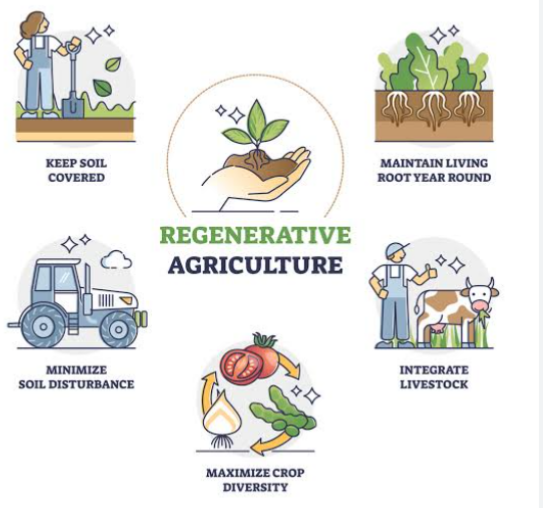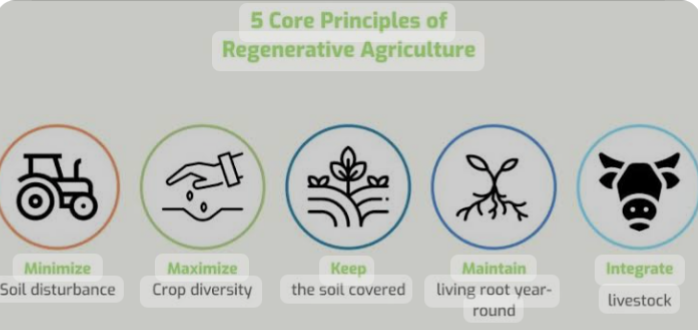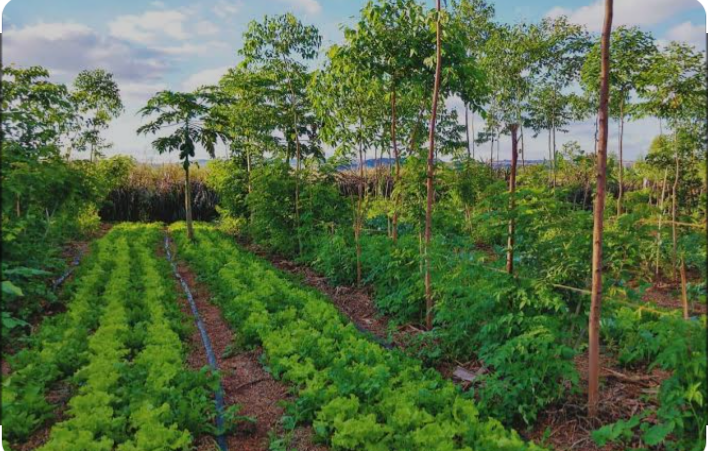
There is need to transform the present state of agriculture to a more reformed productive state so that the needs of the growing population of the world can be met. Agriculture is faced with a lot of challenges that had limited its production level. Some of such problems include over-exploitation of soil nutrients that has left the land barren of nutrients, poor biodiversity, erosion hazards, industrialization, climate change, pest and diseases etc. To overcome these challenges, farmers need to seek for alternative farming practices such as regenerative agriculture which focuses on soil health.
A healthy soil produces more food and nutrition, store or sequester more carbon, and increase biodiversity(the varieties of species). A healthy soil support water, land and air environment and ecosystem through natural processes like water drainage etc.
WHAT IS REGENERATIVE AGRICULTURE
Regenerative agriculture has being defined by many people in different ways but it should be defined based on its principles
Regenerative agriculture (RA) is a strategic food production system where farm inputes are used strategically for agricultural production, nurture and restoration of soil health, protect the climate, water resources and biodiversity, and enhances farms’ productivity and profitability.
It can also be stated to mean the utilisation of practices that promote soil health and utilized regenerative properties to improve the soil and its health. Regenerative agriculture involves the strategic use of various agricultural techniques with modern technological innovations to combat the challenges cause by climate change, over-mining of soil nutrients and distortion of the ecosystem which may affect productivity. Regenerative agriculture blends sustainable innovation with traditional farming practices. It helps to improves soil(that is, restore degraded soils), delivers high productivity and high-quality food, restore lost biodiversity, and ecosystem health. It also address issues that makes the land and waters to be in good conditions to secure the livelihood of future generations. It helps to tackle problems related to climate change, ecosystems, people’ health, and racial equity for farmers and farm workers. It can be practiced on a large scale or small scale farming business.
Regenerative agriculture focuses on improving soil health which had being degraded by the use of heavy machinery, Fertilizers and pesticides in intensive farming. It covers a lot of practices which include ecological grazing, agroforestry, intercropping, where multiple crops are planted together, integrating livestock farming, mixed cropping, and using biological inputs. Through regenerative agriculture resilience is improved , drought is overcome, crop becomes healthier and human health improved both mental and physical
On degraded soils like sandy soils, ranching can be practiced where by forages can be planted for some years and ruminants allowed to feed on the forage grasses. Directly, the animal dung, will help restore the fertility of such soil.
GOALS OF REGENERATIVE AGRICULTURE
1. Produce enough nutritious food for the world’s population
2. Help mitigate climate change by sequestering carbon in soil and reducing greenhouse gas emissions
3. Improve the water cycle and increasing water retention in the soil
4. Strengthening the health and vitality of farm soil.
5. Enhance farmer livelihoods.
6. Reducing reliance on agrochemical such as synthetic fertilisers, herbicides and pesticides.
PRINCIPLES AND PRACTICES OF REGENERATIVE AGRICULTURE

The term regenerative agriculture is more than its name but more of its principles.
Regenerative agriculture is a sustainable farming approaches where the soil is kept healthy inorder to maximize agricultural productivity through the restoration of soils and biodiversity. Regenerative agriculture is underlined by a common set of principles.
1. MINIMIZE SOIL DISTURBANCE
Soil is a medium that supports and house soil micro organisms. Worm-holes, fungal hyphae, decayed organic residues are also found within the soil. All help in improving the condition of the soil.
This principle of minimizing soil disturbance is based upon the negative impacts disturbance can have on the soil especially with deep tillage that causes compaction of the soil whereby air and water find it difficult to stay in the soil. Ploughing or tilling the soil also destroy soil structure. The soil becomes vulnerable to wind and water erosion. Pore spaces becomes sealed up, microbial decomposition become affected, heavy water catchment occurs on soil surface and water retention lessen. The deep rootedness and tunnels created by worms in the soil create spaces that accommodate air and water within the soil. These the soil needs to create healthy plants.
When soils are not disturbed, through No-till or reduced-till, the soil and the climate will benefit. For farmers to practice regenerative agriculture, tillage operation must not be carried out or must be reduced on the soil. Most farmers instead of tilling sow seeds directly into the residue of the previous crop. The previous crop’s stubble decompose to form organic matter which increases the humus content of the soil thereby improving soil fertility and improves the soil structure by binding soil particles together making the soil less prone to wind and water erosion.
In addition, no-till agriculture is a form of carbon sequestration process in the fight against global warming. Undisturbed soil serves as a carbon sink and can thus help mitigate greenhouse gas emissions
2. PLANTING IN THE GROUND ALL YEAR ROUND
Planting crops all year round provide coverage over the soil throughout the year, prevents soil erosion and increases carbon inputs. Growing of cover crops and double cropping can protect the soil surface and when the cover crop residues decompose, they increase the organic matter content of the soil. This keeps the soil healthy for another crop to be planted.
Soil health improves when crops are kept in the ground year-round. Regenerative agriculture farmers plant a different crop immediately after harvest, often alternating cash crops and cover crops. This plant cover shades the soil and the roots dig into it, increasing moisture content within the soil and well aerated soil. The cover crops will also protect the soil from being heated up as this may destroy vital parts of the soil.
3. DIVERSIFY CROPS IN TIME AND SPACE
Soils can become depleted when monocropping is practiced every year. Diversifying crops in space and time supports resilience, productivity, and diversity. This can be achieved through
practices like Crop rotation, interseeding, relay planting and biodiversity strips or agroforestry.
Planting the same crops on the same fields, year after year (monocropping) can result in over mining of soil nutrients and build up of pests and weeds at such farms. In regenerative agriculture, farmers rotate different types of crops over time. This helps limit pest infestations and nourishes beneficial microbes in the soil with a more diverse diet. Rotating between nitrogen-fixing crops like soybeans which also can serve as cover crop and nitrogen-hungry crops like wheat can reduce the need for fertilizers. The cover crop also create a conducive environment for beneficial insects and microorganisms, prevents soil degradation and rejuvenates the soil.
4. OPTIMIZE APPLICATION OF BIOLOGICAL INPUTS AND REDUCE CHEMICAL INPUTS
With organic farming, regenerative agriculture does not rely on chemical pesticides or synthetic fertilizers. Instead, pests, diseases and weeds are managed by using crop rotation to disrupt pest cycles, biological control to combat insect pests, organic pesticides to control pest and diseases and rotational animal grazing to control weeds. Livestock can eat cover crops and produce natural nutrient-rich fertilizer, and crop residues can be composted and returned to the soil.
Biological and chemical inputs such as fertilizers and pesticides need technical know how. The farmer needs to carry out soil and plant analysis to diagnose the deficient nutrients in the soil. This helps to prevent environmental pollution that might result from the utilisation of agrochemicals. There is need to reduce the chemical inputs so as to create a healthy environment. Precision agriculture should be adopted too by farmers.
5. INTEGRATE LIVESTOCK INTO THE SYSTEM WHEN POSSIBLE
Mixed farming is a good practice of regenerative agriculture where both livestock and crops are integrated to give a single farming unit . Livestock as a component can help improve the soil health. Livestock like cattle, goats, sheep, poultry birds, and pigs can be fed with crop residues and transform the plant materials into rich organic matter through manure production. The integrated crops also benefits from the applied livestock manure which increases soil fertility and improved soil structure. This create a mutual benefit among the two components
6. GROW DIVERSE MIXTURE OF DIFFERENT CROPS .
Monocropping can result into pest and disease outbreak, causes erosion and heavy mining of soil nutrients. Companion cropping where two crops are grown at once and separated after harvest, mixed cropping and crop rotation can be practiced in regenerative agriculture. Soil creatures thrive on variety of crops. Nutrients like nitrogen can be made available to crops by legumineous crops included in the cropping systems. Cover cropping can helps protect the soil from erosion, protect the soil from being heated up by the sun and improve soil fertility as they decompose.
In crop rotation, deep rooted crops do follow shallow rooted crops. After harvesting of crops, their roots should be left in the soil. Deep living roots in the soil can create bigger pore space to accommodate more air.
In arable rotation, living roots in the soil are vital for feeding the creatures in the soil. These creatures include bacteria, fungi, protozoa, arthropods and higher creatures that assist in decomposition of organic residues.
Growing of deep roots or big roots in the soil also helps to attract maximum values from the depth of the soil. This also helps to increase water capture in the soil and increase organic matter within the soil. Also, the resilience of the system is increased. This is a key adaptation to climate change.
7. KEEP THE SOIL COVERED AS MUCH AS POSSIBLE. This principle is much of mulch and use of residues to cover the soil surface. This helps prevent erosion occurrence. And protect the soil from sunlight which may heat it up. Organic mulch can retain moisture and increase soil organic matter and increase the water holding capacity of the soil. It can also increase the number of soil microbs as the cover provides an habitable environment for the organisms.
8. KEEP THE SOIL PLANTED AND PLANTED DIVERSELY. Plants are an intermediary between carbon dioxide and organic matter. That is, plants can convert carbon dioxide into carbonaceous roots, leaves, fruits, stems etc. Which are feed upon by animals and micro organisms. The animal excrement such as dung, droppings and faeces can be fed upon by micro organisms to produce manures. When the organisms die, along side with decomposed plant parts and manure, organic matter is formed which is rich in carbon.
Soil organic matter is 50% carbon. This means that when regenerating and building the soil using organic matter, carbon is being added to the soil. So if organic matter is built in the soil, enough water will be conserved in the soil for plant usage. The infiltration level in the soil also directly increases. Therefore, there will not be water catchment on top of the soil and runoff that can wash away rich top soil is reduced or prevented. The infiltration will also prevent water pollution that may occur from runoff water.
The carbon released into the soil result in more microbs developing in the soil, water holding capacity of the soil increases, soil structure is improved, soil becomes healthier and fertile etc. This helps in planting diverse numbers of plants all year round.
9. USE A DIVERSITY OF LIFE PROMOTING INPUTS: such inputs include compost, farm yard manure, green manure etc. The soil works on the principle of give and take back. Every nutrients removed from the soil must be returned back to the soil. If the nutrients are not replaced, the soil will become As and yield decreases. The principle of reciprosity must be adhered to so that the soil can be kept healthy and productive. Use of compost and manures will help increase microbial biomas, increase soil organic matter, increase water holding capacity and infiltration level
CHARACTERISTICS OF REGENERATIVE AGRICULTURE
1. Reduce or no tillage is practiced
2. Protect or cover the soil using cover crops
3. Uses organic method for farming
4. Uses natural method to control pests
5. Uses cover crops and crop rotation
6. Uses crop plant diversely e. g intercropping
7. It restore natural habitat
8. Integrate livestock in the farming operation
9. Incorporated perrenials and trees
10. Uses ecological or natural principles etc.
DIFFERENCES BETWEEN REGENERATIVE FARMING AND CONVENTIONAL FARMING
Regenerative farming and conventional farming differ from one another in the following ways:

1. SOIL HEALTH : Regenerative farming improves and maintaining soil health. Practices such as no-till farming, cover cropping, and composting are used to enhance the health of the soil, increase organic matter, and promote beneficial microbial activity. While in conventional farming, Monoculture or monocropping is practiced. A single crop is grown over a large area of land. This can lead to increased pest and disease pressure and may require more chemical inputs. Also, extensive tilling of the soil is done prior planting. This can lead to soil erosion, loss of organic matter, and degradation of soil health
2. BIODIVERSITY : Regenerative farming encourages biodiversity both above and below the ground. This includes crop rotations, planting cover crops, and preserving natural habitats for all sorts of living creatures. While in conventional farming
monocultures is practiced and chemical inputs are used. These brings about a reduction in biodiversity.
3. CHEMICAL USAGE : In Regenerative farming, use of agrochemicals is minimized. Agrochemicals such as synthetic herbicides, pesticides and fertilizers are not used. Instead, it often relies on natural solutions, like biological pest control and nutrient cycling. On the other hand, conventional Agriculture rely heavily on agro chemical usage to maximize crop yield and control pests.
4. CARBON SEQUESTRATION : One of the aim of regenerative farming is to sequester carbon in the soil. Healthy soils can help mitigate climate change by drawing down atmospheric carbon dioxide and storing it in the ground. While conventional agriculture causes soil degradation and contribute to greenhouse gas emissions rather than carbon sequestration. For example, Fumes from exhaust pipes of the machine used for tillage.
5. SUSTAINABILITY : Regenerative farming contribute to long-term sustainability of the land. The farming practices are often in harmony with nature. While conventional farming degrades the soil and affect the health of the soil negatively.
6. TILLAGE OPERATIONS : In regenerative agriculture no till or minimum tillage is done. This helps in improving the health of the soil. While in conventional farming, heavy machines are used for tilling the ground. This affect the soil structure, causes soil compaction and other effects that can reduce productivity.

IMPORTANCE OF REGENERATIVE AGRICULTURE
1. It improves soil health
2. It improves crop yield
3. It retains moisture in the soil
4. It reduces erosion
5. It increases infiltration in the soil
6. It reduces green house gas emission
7. It increases the organic matter content of the soil
8. It helps restore agricultural lands
9. It sequester carbon into the soil
10. More efficient water usage
11. Pest and diseases are reduced in the farming practices
12. It increases farmers income
13. less chemical pollution on ground and surface water
14. Brings about better soil water holding capacity and groundwater recharge,
15. Water conserved on the farm or ranch can be achieved.
16. Reduction in cost of production. Cost of purchasing agro chemicals used on crops and livestocks can be diverted into other enterprise.
17. Regenerative agriculture brings joy and happiness to farmers.
18. Risk of failure of enterprise are overcome through integrated farming practices
19. Healthier working environment for farmers
20. Agroforestry supports pollinators

TERMINOLOGIES
CROP DIVERSITY : Planting a wide variety of crops rather than relying on a single monoculture.
INTERSEEDING : is when cover crops are planted between commercial crop rows. The cover crops prevent erosion and evaporation of moisture from the soil.
RELAY PLANTING means inserting the seeds of the next crop on the field eventhough the first crop is on growing. This will enhance the profitability of farmer and adequate utilisation of nutrients from parts of the soil.
BIODIVERSITY STRIPS means planting at the margins of fields or planting trees and shrubs around the boundaries of farmland (agroforestry) create habitats for pollinators and other beneficial wildlife. The trees also supply living mulch for the crops planted or fodder for livestock. The trees or shrubs also serve as windbreaks which prevent crop logging.
PRECISION AGRICULTURE : A farming system that uses GPS technology involving satellites and sensors on the ground and intensive information management tools to understand variations in resource conditions within fields. This information is used to apply fertilizers and other inputs more precisely and to predict crop yields more accurately.
CROP ROTATION : This is the practice of growing a series of different types of crops in the same area across a sequence of growing seasons. This practice reduces the reliance of crops on one set of nutrients, pest and weed pressure, along with the probability of developing resistant pests and weeds.
ECOSYSTEM : This is a community or group of living organisms that live in and interact with each other in a specific environment.
